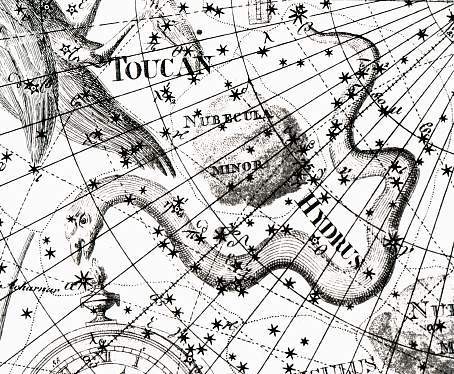
The counterpart to the larger Hydra constellation, Hydrus is also known as ‘the lesser water snake’ and is separated by the constellations Eridanus and Orion as well as the Milky Way. Hydrus, in Latin means ‘the male water snake’ and lies between the two Magellanic Clouds, between the constellation Eridanus and the south celestial pole. A constellation in the southern hemisphere, Hydrus first appeared on a celestial globe by the Dutch astronomer Petrus Plancius in 1597 and was subsequently included as a part of Johann Bayer’s star atlas Uranometria in 1603. Hydrus was created by Plancius in the late 16th century from the observations of the Dutch sailors Frederick de Houtman and Pieter Dirkszoon. As mentioned earlier, it belongs to the Johann Bayer family of constellations and is best visible in the month of December.
Some of the notable stars of this constellation are:
- β Hydri (Beta Hydri): It is the brightest star in the constellation and has a visual magnitude of about 2.80. It is basically a yellow sub giant and is around 3.494 more luminous than the sun. Beta Hyrdi is believed to be one of the oldest stars situated in the sun’s neighborhood and is the nearest sub giant star to the solar system. It is around 24.33 light years away from the sun.
- α Hydri (Alpha Hydri): Alpha Hyrdi, also termed as the Head of Hydrus is the second brightest star in the constellation. It is a yellow–white sub giant star with a visual magnitude of 2.90 and is about 71.8 light years away. Alpha Hydri is around 32 times brighter than the sun and is believed to be around 810 million years old.
- y Hydri (Gamma Hydri): Gamma Hydri is basically a red giant with a magnitude of about 3.24 and is the third brightest star in Hydrus. The star is around 214 light years away from the earth. It is also 655 times brighter than the sun.
- δ Hydri (Delta Hydri): It is a white dwarf. With a visual magnitude of about 4.08, it is about 140 light years away.
- η2 Hydri (Eta-2 Hydri): It is a yellow giant, has a visual magnitude of 4.68 and is about 219 light years away from the solar system.
- e Hydri (Epsilon Hydri): It is blue-white giant with a visual magnitude of 4.06.
- v Hydri (Nu Hydri): It is an orange giant star with a visual magnitude of 4.75 and is about 339 light years away from the earth.
- z Hydri (Zeta Hydri): It is a white star which is half the way in its evolution stage between the sub giant and dwarf stage. Zeta Hydri has a visual magnitude of 4.83 and is about 284 light years away from the solar system.
- GJ 3021 (2 G.Hydri): GJ 3021 is a double star in Hydrus Constellation, which is located about 57 light years away. It is a yellow dwarf, with a visual magnitude of 6.59. In the year 2000, an extra-solar planet was discovered orbiting the star.
- HD 10180: HD 10180 is another sun–like star in Hydrus. It is a yellow dwarf with a visual magnitude of 7.33 and is about 127 light years away from the solar system. The star is also 149 percent brighter than the sun. The estimated age of HD 10180 is about 7.3 billion years.
Out of the numerous deep sky objects in the constellation, a few of them include:
- IC 1717: It was basically a deep sky object and was initially catalogued by the Danish astronomer John Louis Emil Dreyer. It has been described as a small and faint object located near the giant yellow star Eta–2 Hydri.
- NGC1511: NGC 1511 is a spiral galaxy in the constellation with a visual magnitude of about 11.0. It was discovered by the British astronomer John Herschel on 2nd November, 1834.
- NGC 1466: It is basically a globular cluster in Hydrus. With a visual magnitude of 11.4, it is around 14,000 light years away.
- NGC 1473: It is an irregular galaxy in the constellation. It has visual magnitude of 13.0.
Hydrus lies in the first quadrant of the southern hemisphere and can be seen at latitudes between +8° and -90°.

It occupies an area of 243 square degrees, making it the 61st constellation in size.
It does not have any myths or stories associated with it as it was created to represent the snakes, which the Dutch navigators would have seen during their voyages.
Hydrus is surrounded by constellations like Dorado, Eridanus, Horologium, Mensa, Octans, Phoenix, Reticulum and Tucana.


